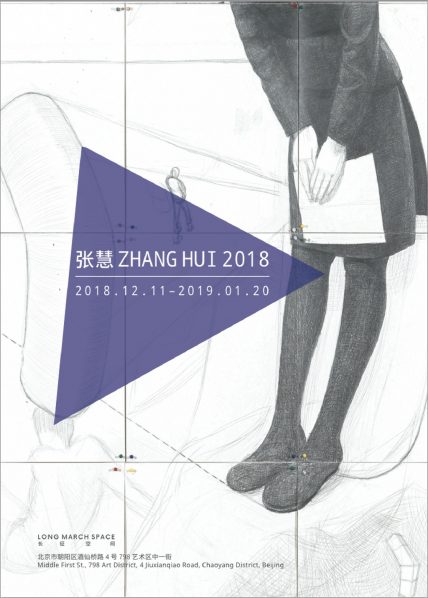
Long March Space announces Zhang Hui’s solo exhibition “Zhang Hui 2018”, opening on December 11th, 2018. Continuing Zhang Hui’s thinking on the perception of images, his recent work also
opens up a new topic of exploration, exhibited here for the first time. Leaving behind the context of narrative in painting bound by physical momentum, the paintings build their power from the interaction between confrontation in physical space and the structural, almost architectural significance of people’s postures.
The exhibition expands upon the visual language that has emerged over the course of the three major transformations in Zhang Hui’s career (his shifts from action and installation art, to multimedia theatre, and on to painting). The image itself now sits at the center of his creative process. Although all 13 paintings exhibited depict people, they lack clearly defined identities and intentions. The artist focuses on the relationship between the human body and the spontaneous vertical tension of its upright posture, which forms the implied energy transfer on the canvas, a flow that is reflected throughout all of the works. A visual game is played out between the viewers and the images: the different angles at which people are placed constitute a continuous process, where the field the individual themselves is located in is transformed into a pristine gravitational space. Like a vertically oriented building, it is filled simultaneously with the strength holding it together, and the potential for collapse. Fragments of the human form are reproduced on a small scale over larger areas of the image, both echoing and creating discontinuities within the picture as a whole.
In the language of Zhang Hui’s images, background, faces, and objects tend to be indistinct. The longer one studies the paintings, the harder it is to judge the true intentions of the people moving inside them. The cleaner may not be cleaning the floor, but rather facing a cat with a stick in her hand; the worker may not be surveying the site, but instead seemingly confronting a slightly diagonal wall. The flight attendant bows her head, creating an air buffer beneath a piece of paper. Real circumstances and identity come together to constitute a false reality. The potential energy of each piece goes beyond what is contained in the canvas, negating the possibility of narrative interpretation constrained within the image itself. At the same time, Zhang Hui implants lumps of color without specific form into the paintings, collapsing the picture plane and individual energy.
Through such means of decentralization and differentiation the language of the image is re-processed, highlighting the essential nature of visual perception. In this new stage of Zhang Hui’s painting, he has begun to think about the contradiction of movement present in humans and objects, conveying a reconstructed logic and surging state of life that is nakedly represented on the canvas. The methodology of Zhang Hui's investigations into posture invokes, to put it in Warburg's words, the Pathosformel, which in its dialectical movement transcends time, and with its potential energy returns to the point of origin.
About the artist
Zhang Hui was born in 1967 in Heilongjiang Province, graduated in 1991 from the Central Academy of Drama, and currently lives and works in Beijing. He was an important member of the Post-Sense Sensibility Group active in the Chinese contemporary art world in the late 1990s and early 2000s, after which in 2004 he founded the Odd Phenomena Group. In his early explorations, Zhang Hui developed an artistic practice focused on action and installation, which in his later practice centered on explorations into multimedia theatrical performance. In 2006 he shifted his focus to the language of painting, and to date has held six solo exhibitions of his paintings at Long March Space. Zhang Hui takes painting as a mode of investigation to undertake a performative exploration of duration and its relationship to ideas of time and space. His works conceal eminently readable and bewitching theatricality within them, simultaneously profoundly rethinking
the truth and uniqueness of known reality, and striving to expand the structure behind real events and their images.
About the exhibition
Dates: 12.11.2018 – 1.20.2019
Venue: Long March Space, Beijing
Address: 798 Art District, 4 Jiuxianqiao Rd, Chaoyang District, Beijing
Courtesy of the artist and Long March Space.




























